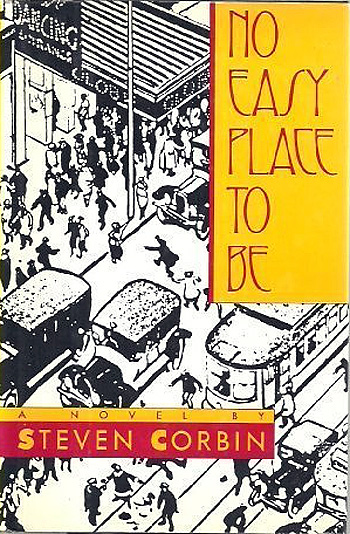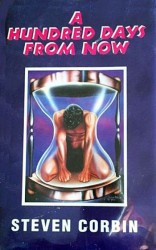Black and Gay Identities in the Fiction of Steven Corbin (1953-95)
by Stephen O. Murray
October 20, 1993.
Steven Corbin’s first novel, No Easy Place To Be (1989), seems to me both more ambitious and more accomplished than his second, Fragments That Remain (1993).

Simon & Shuster, Jan. 1989
I don’t entirely believe that the attitudes and means of expression in Place are authentic 1920s Harlem, but the world of the writers (Scott, Rudy, Velma) feels like a plausible one, with a backdrop of real Harlem Renaissance figures. Louise jumping from the Cotton Club to passing as white and marrying a rich Italian stockbroker also has verisimilitude. And passing was a major concern, as in Jessie Fausset’s novel of that name. The third sister, Miriam, has less spectacular a life, turned on and then dropped by a fellow nurse, Agnes. The novel stretches from a 1919 WWI victory parade to the stock market crash of 1929.
The technique of filling in details about events already covered is a bit awkward, but the stories of three sisters and three writers (with one overlap of the two triads) works better than the attempt to portray the perspectives of all four members of the black family plus the white lover of one in Fragments That Remain. Both are very readable.
Fragments That Remain showed the conflict between the protagonist’s mother’s homosexual (but “no punk”) brother and the father who exclaims with contempt that his brother-in-law “got the nerve to be proud of being a freak” (p. 277). Corbin also portrayed the high school verbal hazing of the coterie of boys of his own generation who recognized their homosexual desire and had it recognized by classmates (pp. 139-50), concluding with a new generation’s realization that “faggots and punks weren’t necessarily synonymous.” (Rudy in Place also showed this.)
The narrator of Corbin’s third novel, A Hundred Days From Now (1994), recalled as “his premiere gay role models—openly effeminate gay men and drag queens whom people feared and respected.” Growing up in Jersey City’s black ghetto during the 1960s, “flamboyant, effeminate homosexuals and drag queens were known to parade up and down the streets without being bashed or harassed. The fact that most of them were ex-convicts and not to be messed with had plenty to do with it” (pp. 80–81).

Alyson Books, June 1994
A Hundred Days From Now centers on a black screenwriter (Dexter) caring for a Mexican-born, Seattle-raised closeted businessman with AIDS (Sergio). It is interesting but in some ways implausible. Sergio would be more credible if he had been raised rich in Mexico rather than poor in Seattle by a single Nordic mother who had left his Mexican father. Clarifying what Dexter and Sergio did in bed might be useful (though Latino pasivos can be at least as demanding as activos!).
I find it hard to believe that Sergio’s father, Raúl, took his son’s coming out with equanimity—or that Sergio’s twin brother does not know Sergio is gay or sick (until he is approached to provide bone marrow to transplant).
In contrast, I find the animus towards Dexter from Berta, Raúl’s second wife, plausible. I know that there were physicians afraid to approach AIDS patients (I don’t think she’s in the “it’s leukemia” collusion). There’s rather too much pleading “I did more than anyone could expect me to do,” too, and too much telling, too little showing (for a novel, let alone for a screenwriter!) and some really clunky dialog. Plus Dexter is unbelievably saintly in his devotion and Sergio a monster of selfishness, dependent as he becomes on Dexter as a caregiver.
In Fragments That Remain, the gay black narrator Skylar is almost as ambivalent about his white lover Evan’s racial specialization in partners as he is about his black father’s self-loathing and jealousy of his gay son.
Like most black gay men, I stand on the periphery of the gay community, something Evan can’t understand. I don’t see myself represented in Gay Pride Week, during the parades, in the bars, in the press…. The gay community only minimally represents me. Some of the most bigoted people I’ve met are gay. While the gay liberation and pride movement has its important function in society, it’s the result of millions of white, male, often blond and blue-eyed people who never before had to deal with bigotry, feeling appalled that they could be denied a civil right—or denied anything in this country. (p. 311)

Alyson Books, June 1993
Like many (most?) African Americans, Skylar seems unable to comprehend that the (fetishistic, at least in Corbin’s case) reduction of white men to blonds with blue eyes might strike European-Americans with other colorations, as might the invisibility of any but black and blond men in gay African American discourse as racist, leaving aside the not-wholly-positive valuation of blond(/e)s in American culture and representations—and the outright use of blue eyes as a metaphor of male effeminacy by the recurrently homophobic Nobel Prize-winning African-American novelist Toni Morrison (in The Bluest Eyes). (Sergio, the Mexico City-born lover of the black writer Dexter in A Hundred Days From Now, has a Mexican father but a Nordic mother so that he, too, has blue eyes, although culturally he is very Latino elite—indeed, too Latino elite to have been raised by his Anglo mother struggling to make ends meet in Seattle. Early in the novel and their relationship, “Dexter was proud to be seen with” his blue-eyed trophy (p. 27).)
At a black-white gay rap group Skylar and Evan attend (in Fragments That Remain), one African-American complains that “when white people see me, they don’t see a gay man. They see a black man.” Another spits out, “White faggots don’t like niggers any more than white America!” (p. 175).
It is hard to sort out self-conception from how and as what a self is regarded by significant others, and projections run both ways across racial divides in contemporary America—as vividly, if melodramatically, represented in Fragments, pp. 175–76, and by others, especially around sexual desires for otherness. For African American males involves passionately in intraracial same-sex relations, there is dissensus over whether they are in a “life” or only a lifestyle [“down low”].
Corbin died in New York City in 1995 from AIDS-related complications. The LA Times Obituary says he was 4 when he died, but the author’s birth year in A Hundred Days is listed as being 1953. An affectionate memoir Mark Sarvas as a writing teacher/mentor is online (URL below). It makes clear that A Hundred Days was a roman à clef about his own partner’s losing struggle with HIV, at a time Corbin was still asymptomatic. These jottings were written while he was still alive, I talked very briefly to him at a July 1993 bookstore appearance in San Francisco at Alexander’s.
References
Corbin, Steven. 1989. No Easy Place To Be. NY: Simon & Schuster.
—. 1993. “The black and white of interracial couples.” Genre 14:49–51.
––. 1993. Fragments That Remain. Boston: Alyson.
—. 1994. A Hundred Days From Now. Boston: Alyson.
Murray, Stephen O. 1996. “Some Gay African-American Self-Representations from the 1980s and 90s.” pp.246–57 in American Gay. Chicago: University of Chicago Press.
Image Source: Sarvas, Mark. “In Memoriam: Steven Corbin.” The Elegant Variation. October 16, 2014.
©1993, 1995, 2016, Stephen O. Murray
(20 October 1993, 4 March 1995)


